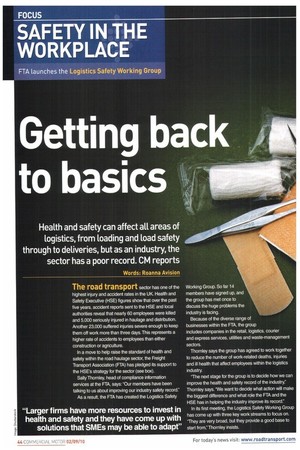Getting back to basics
Page 44

Page 45

If you've noticed an error in this article please click here to report it so we can fix it.
Health and safety can affect all areas of logistics, from loading and load safety through to deliveries, but as an industry, the sector has a poor record. CM reports
Words: Roanna Avision The road transport sector has one of the highest injury and accident rates in the UK. Health and Safety Executive (HSE) figures show that over the past five years. accident reports sent to the HSE and local authorities reveal that nearly 60 employees were killed and 5.000 seriously injured in haulage and distribution Another 23,000 suffered injuries severe enough to keep them off work more than three days This represents a higher rate of accidents to employees than either construction or agriculture.
In a move to help raise the standard of health and safety within the road haulage sector, the Freight Transport Association (FTA) has pledged its support to the HSE's strategy for the sector (see box).
Sally Thornley, head of compliance information services at the FTA. says' -Our members have been talking to us about improving our industry safety record.'
As a result, the FTA has created the Logistics Safety Working Group. So far 14 members have signed up, and the group has met once to discuss the huge problems the industry is facing Because of the diverse range of businesses within the FTA. the group includes companies in the retail, logistics, courier and express services utilities and waste-management sectors.
Thornley says the group has agreed to work together to reduce the number of work-related deaths, injuries and ill health that affect employees within the logistics industry.
"The next stage for the group is to decide how we can improve the health and safety record of the industry," Thornley says. "We want to decide what action will make the biggest difference and what role the FTA and the HSE has in helping the industry improve its record."
In as first meeting, the Logistics Safety Working Group has come up with three key work streams to focus on. They are very broad but they provide a good base to start from." Thornley insists.
The three areas are:
• How the FTA can disseminate information about best practice to its members. Thornley believes there is a way to use the best practices employed by the larger companies to help the smaller businesses in the sector improve their health and safety procedures.
-Larger companies have more resources to invest in health and safety procedures and they have come up with solutions that smalland medium-sized companies may be able to adapt to suit their requirements."Thornley points to Tesco, which includes health and safety considerations in its planning before it will even purchase a new site for development, and Royal Mail, which has
developed the safety truck (CM 26 August) specifically to make sure its drivers are as safe as possible, as examples the industry could learn from.
• Identify hotspots and work to resolve those issues without creating more risks. "A good example of this is loading; Thornley says -You resolve load safety issues by securing the load in a better way with more restraints, but this can create working-at-height problems that then need to be addressed • Looking at what would be appropriate measures for health and safety performance within the logistics sector.
The HSE has a detailed document (http://bit. ly/bJp70y) considering the issues of health and safety in logistics because of the industry's poor record, but, Thornley says, the group wants to use the document as a basis to create some measures to show how the industry has improved. While admitting the themes are very broad. Thornley says the group hopes to work through the issues and come up with some solid suggestions that the industry can use to help improve the sectors health and safety record.
The FTA has not set a specific timetrame for the group. but Thornley says any input from other FTA members would be welcome •
• Any FTA member can sign up to the Logistics Safety Working Group by contacting Sally Thornley on sthornley@fta.co.uk
























































































































































































































































